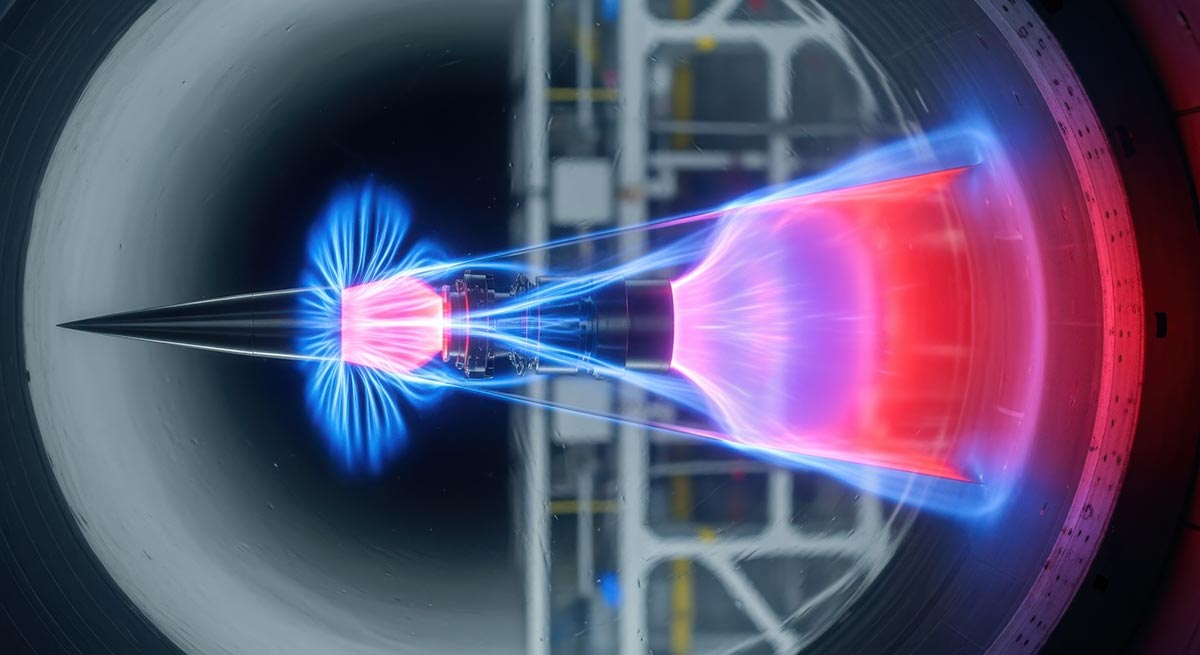In hypersonic aerothermodynamics, the interplay of physical processes often reveals itself most clearly in what is not in equilibrium. One of the most critical, yet frequently overlooked, aspects of nonequilibrium plasma behavior in high-speed high-altitude flows is the relaxation of electron energy—a process that affects transport processes, electromagnetic interactions, and ultimately, the feasibility of active flow control strategies.
While much attention has been paid to the macroscopic consequences of ionization and recombination, the microscopic behavior of the electron energy distribution function (EEDF) plays a central role in determining how a weakly ionized plasma will behave in a hypersonic environment.
Nonequilibrium is the Rule, Not the Exception
When air passes through a hypersonic shock or is subjected to localized energy deposition—whether from a laser, a microwave field, or a nanosecond pulsed discharge—it enters a state of strong thermochemical nonequilibrium. Molecules are excited, dissociated, and, at high temperatures, ionized. However, due to the vastly different time scales involved, electrons often attain energy distributions that are far from equilibrium with the bulk gas.
In weakly ionized plasmas, the electron number density may be orders of magnitude lower than the neutral gas density, but the electrons can reach high energies sufficient to ionize or dissociate molecules through inelastic collisions. Crucially, the EEDF is typically not Maxwellian under such conditions, particularly in the initial stages of plasma formation or in pulsed regimes. Instead, it may contain high-energy tails, which disproportionately contribute to reaction rates.
This presents a challenge: most engineering-level plasma models assume a Maxwellian EEDF, using a single local electron temperature to characterize the energy content of electrons. While computationally efficient, this assumption can lead to significant errors in predicting ionization rates, electron transport properties, and even electromagnetic wave absorption.
Relaxation Time Scales: The Key to Understanding Plasma Dynamics
The electron energy relaxation time—that is, the time it takes for a nonthermal EEDF to equilibrate with the surrounding gas or to react to changes in the electric field—is governed in molecular gases primarily by inelastic collisions with molecules and atoms. The rate of inelastic collisions is typically about 10-1000 times lower than the rate of elastic collisions.
For example, in air at atmospheric pressure, the energy relaxation time for electrons is typically on the order of nanoseconds. However, in low-pressure, high-speed flows such as those encountered in the upper atmosphere or in hypersonic boundary layers, the relaxation can take microseconds or longer—comparable to or exceeding the residence time of the gas in the region of interest.
This mismatch of time scales means that in many practical hypersonic applications, electrons will not equilibrate before the gas has moved downstream, and transient electron energy distributions will govern plasma behavior. Moreover, in low-pressure pulsed discharges used for flow control or plasma-assisted combustion, the EEDF or electron temperature will not follow the rapid changes in electric field, reacting instead to an average field value and keeping memory of the earlier values of the field.
The slow electron energy relaxation in high-altitude rarefied air affects not only temporal, but also spatial behavior of electron temperature and EEDF. The electron energy relaxation length is typically 10-1000 times longer than the mean free path. As a consequence, in low-pressure plasmas sustained by electric or electromagnetic field, the electron temperature and EEDF are no longer just functions of the local field strength. This is known as non-local behavior.
Implications for Electromagnetic Interactions and Plasma Flow Control
An additional important factor is that while at low pressure (high altitude) the electron energy relaxation is slow, the electron heat conduction is fast. As a consequence, the electron temperature and EEDF are often uniform in the entire centimeter- or meter-scale hypersonic shock layer and even beyond it.
One practical consequence of slow electron energy relaxation and non-local behavior is its impact on microwave propagation and absorption. In a plasma-based communication blackout mitigation system, for example, the electron collision frequency—which determines both conductivity and dielectric properties—depends on the EEDF. An EEDF computed with conventional solvers may yield incorrect estimates of signal attenuation or reflection unless the non-locality is properly accounted for.
Similarly, for plasma actuators that rely on the Lorentz force or Joule heating, the spatial and temporal variation of electron energy affects the force distribution and heat input.
Accurate modeling requires either solving the non-local Boltzmann equation for the EEDF directly (a computationally expensive task) or developing and employing reduced-order models that capture essential features through moment-based or hybrid approaches.
